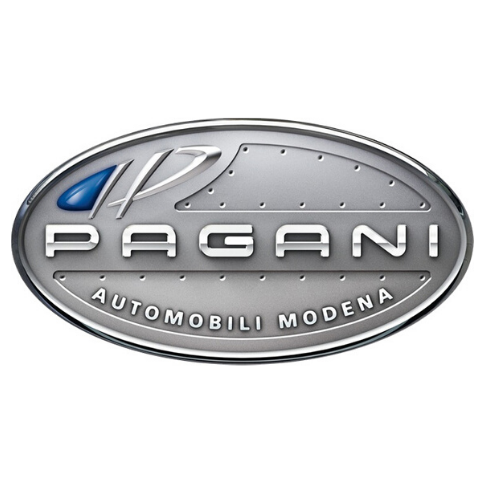Logo
The logo bears the complete name of its company and was designed in a more stylish way unlike other car logos. It completely presents prestige through its metallic badge. It shows an idea of being proud of its roots by having a large “P,” complete PAGANI name at the middle and an automobile Modena that says it all.
Company
Horacio Pagani, an Italian born in Argentina, first directed the Department of composites Lamborghini before founding the company Pagani Composite Research in 1988.
This new company then worked for several projects Lamborghini, whose edition of the Countach for its 25th anniversary, the concept design of the P140 and Diablo. In the late 1980s, Pagani began designing his own car at the time known as the C8 Project. Pagani's projects was to rename Fangio F1 at its output, to honor the five-time world champion Formula 1 Juan Manuel Fangio.
In 1991, the company creates Pagani Modena Design to meet the growing demand of the parent company for its designs, engines and prototypes. In 1992 he began building the prototype Fangio F1 and in 1993 the car was tested in the Dallara wind tunnel with convincing results. In 1994, Mercedes-Benz agrees to provide the firm with its V12 engine.
Pagani's first model, the Zonda, is propelled by mid-mounted V-12 DOHC engines manufactured by Mercedes-Benz's AMG division. The car's design was inspired by jet fighters and the famous Sauber-Mercedes Silver Arrow Group C cars, and features several unique design elements, including its circular four pipe exhaust.
The Zonda production run includes 15 track-only Zonda R models of which 5 will be Revolucion models as well as several "limited edition" Zonda cars in following years.
The successor to the Zonda was the Pagani Huayra. It is named Huayra after the Incan god of wind. Pagani expects to build no more than 40 each year and each will sell for £1,000,000. The engine is a M158 twin-turbo 6.0 Litre V12 from Mercedes' AMG division producing 720 horsepower (537 kW) and 1,000 N·m (740 lb·ft) of torque.
The Huayra's main body is made from carbotanium; a composition of carbon fiber and titanium, thus it is reasonably lightweight. The Huayra has been redesigned from the ground up, but shares many visual qualities with the outgoing Zonda. The top speed has gone up from the 220 mph (350 km/h) (set by the Zonda F Roadster) to 235 mph (378 km/h), and the 0–100 km/h time is 3.2 seconds. When the car was driven round the Top Gear test track by The Stig it set a lap time of 1:13.8, making it the fastest road car round the track.
History
Horacio Pagani, who formerly managed Lamborghini's composites department, founded Pagani Composite Research in 1988. This new company worked with Lamborghini on numerous projects, including the restyling of the Lamborghini Countach 25th Anniversary Edition, the Lamborghini LM002, the P140 design concept, and the Diablo. In the late 1980s, Pagani began designing his own car, then referred to as the "C8 Project". Pagani planned to rename the C8 the "Fangio F1" to honour his friend, the Argentinian five-time Formula One champion, Juan Manuel Fangio.
In 1991, Pagani established Modena Design to meet the increasing demand for his design, engineering, and prototyping services. In 1992, he began construction of a Fangio F1 prototype, and by 1993, the car was being tested at the Dallara wind tunnel with positive results. In 1994, Mercedes-Benz agreed to supply Pagani with V12 engines. The cost of these cars are at a total of 2.3 million dollars.
The final car was named the Zonda C12, the first of the Zonda line (the Fangio F1 name was dropped out of respect for Fangio, who died in 1995). It was first presented at the 1999 Geneva Motor Show.
In 2005, Pagani announced that it planned to triple its production output within the next three years, and to enter the US market in 2007.
On 30 June 2010, Pagani claimed a new record for production-based cars using the Pagani Zonda R and completing the Nürburgring in 6:47, beating the Ferrari 599XX.
